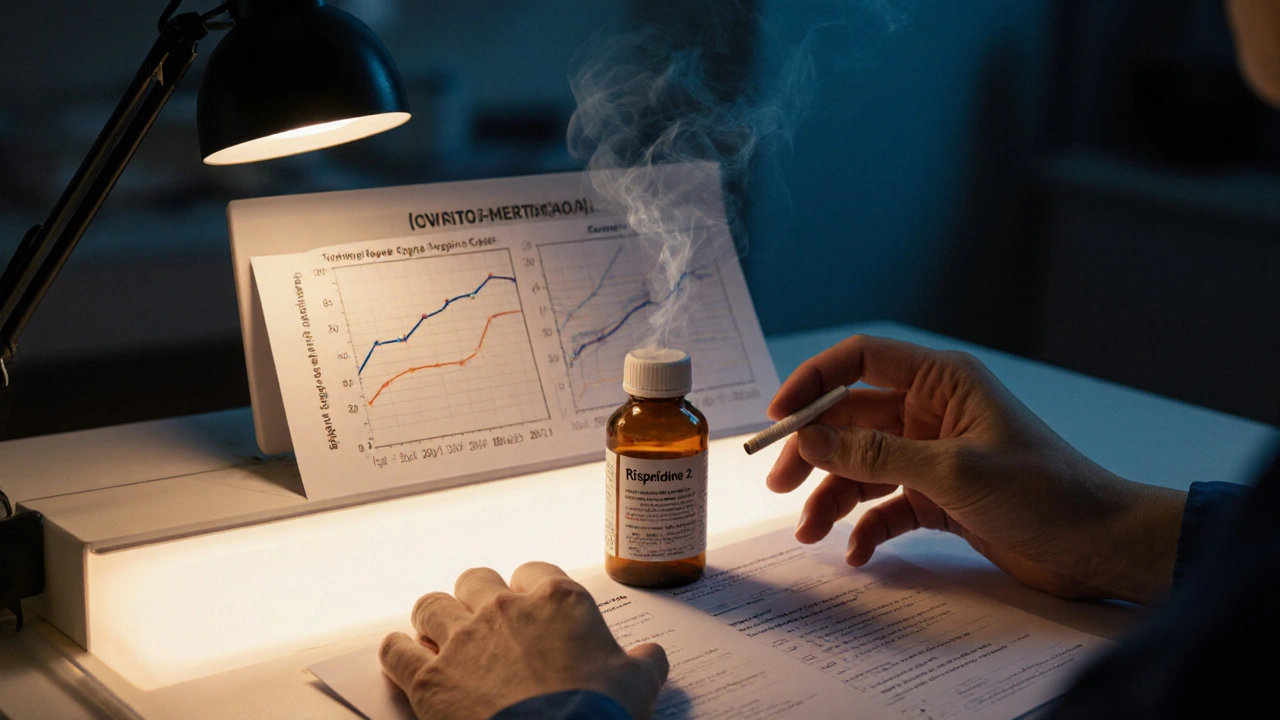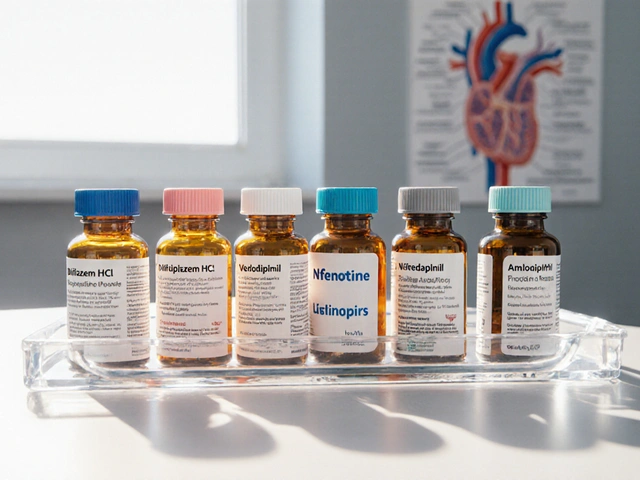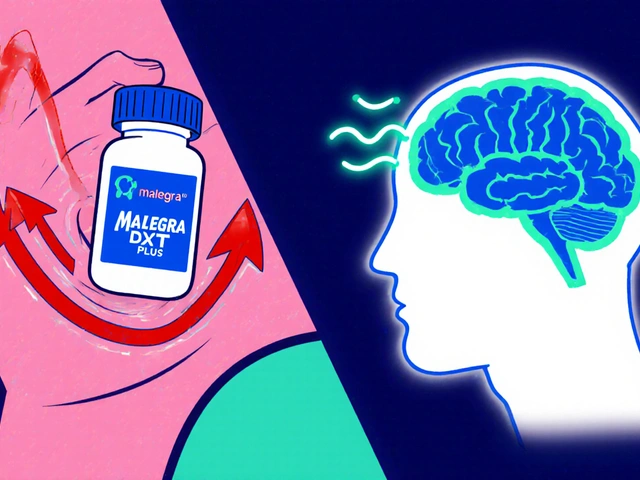Antipsychotic Decision Aid Calculator
Treatment Selection Criteria
Answer these questions to get a tailored recommendation for antipsychotic selection.
Treatment Recommendation
When it comes to treating severe schizophrenia, Clozapine often gets the spotlight. Clozapine is a second‑generation antipsychotic approved for patients with treatment‑resistant schizophrenia. Its unique receptor profile (high affinity for D4, 5‑HT2A, and low D2 blockade) gives it potent efficacy, but it also carries a set of serious side‑effects that make clinicians think twice before prescribing it.
Why look beyond Clozapine?
Even though Clozapine can reduce psychotic symptoms when other drugs fail, the need for regular blood monitoring, the risk of agranulocytosis, and metabolic concerns push many prescribers to explore other options. Patients may also have personal preferences, insurance constraints, or previous adverse reactions that rule out Clozapine.
Top oral alternatives
Below are the most commonly considered alternatives, each with its own benefit‑risk profile.
- Risperidone is a first‑generation atypical antipsychotic that offers good efficacy for positive symptoms while being relatively cheap.
- Olanzapine provides strong symptom control but is notorious for weight gain and lipid disturbances.
- Quetiapine has a calming effect and is often used for patients with comorbid insomnia or anxiety.
- Haloperidol is a classic high‑potency antipsychotic useful when rapid tranquilization is needed, though it can cause extrapyramidal symptoms.
Key conditions to keep in mind
Understanding the disease context helps match a drug to the right patient.
- Schizophrenia is a chronic mental disorder characterized by delusions, hallucinations, and cognitive impairment.
- Treatment‑resistant schizophrenia describes cases where at least two different antipsychotics at adequate doses fail to produce sufficient improvement.
- Agranulocytosis is a rare but life‑threatening drop in white blood cells, most famously linked to Clozapine.
- Metabolic syndrome includes weight gain, high blood glucose, and abnormal cholesterol-side‑effects seen with many atypicals.
Side‑effect snapshot
The table below lines up the most relevant advantages and drawbacks for each drug.
| Drug | Typical Use | Key Strengths | Major Risks | Monitoring Needs |
|---|---|---|---|---|
| Clozapine | TRS (treatment‑resistant) | Highest efficacy for refractory psychosis | Agranulocytosis, myocarditis, seizures, metabolic effects | Weekly CBC for first 6weeks, then bi‑weekly |
| Risperidone | First‑line for acute episodes | Good control of positive symptoms, low cost | Prolactin elevation, mild weight gain | Baseline metabolic panel, periodic prolactin if symptomatic |
| Olanzapine | Severe psychosis, mood‑stabilizing adjunct | Strong symptom reduction | Significant weight gain, diabetes risk, lipid abnormalities | Quarterly weight, fasting glucose, lipids |
| Quetiapine | Schizoaffective, insomnia, anxiety comorbidity | Sedating, helpful for sleep | Orthostatic hypotension, modest metabolic impact | BP checks, periodic metabolic labs |
| Haloperidol | Acute agitation, emergency settings | Rapid tranquilization, inexpensive | Extrapyramidal symptoms, tardive dyskinesia | Movement disorder screening, ECG if high dose |
Decision criteria - how to pick the right antipsychotic
- Clinical response history: If two or more non‑Clozapine agents have already failed, Clozapine becomes the logical next step.
- Side‑effect tolerance: Patients worried about weight gain may prefer Risperidone or Haloperidol, while those who dread blood draws might avoid Clozapine.
- Medical comorbidities: Diabetes or heart disease tip the scales away from Olanzapine and toward agents with lighter metabolic footprints.
- Monitoring capacity: Clinics lacking reliable weekly CBC capability should consider alternatives that need less intensive labs.
- Drug interactions: Clozapine is metabolized by CYP1A2. Smoking, fluvoxamine, and certain antibiotics can raise or lower its levels dramatically.

Practical tips for switching or initiating therapy
- Cross‑taper carefully: When moving from a high‑potency typical (e.g., Haloperidol) to an atypical, reduce the former by 25% every 2‑3days while starting the new drug at a low dose.
- Educate the patient: Explain the purpose of weekly blood tests for Clozapine and the warning signs of agranulocytosis (fever, sore throat).
- Use a dosing calculator: For Clozapine, start at 12.5mg once or twice daily and increase by 25mg every 2days, aiming for 300‑600mg/day based on response.
- Monitor metabolic parameters: Even if you choose Risperidone, check weight, fasting glucose, and lipids at baseline and then every 6months.
- Document smoking status: Since nicotine induces CYP1A2, a change in smoking habit can alter Clozapine levels by up to 30%.
Common pitfalls and how to avoid them
Many clinicians stumble over a few recurring issues.
- Skipping baseline labs: Starting any antipsychotic without a metabolic panel leaves you blind to future changes.
- Under‑recognizing drug interactions: Fluoxetine, ciprofloxacin, and oral contraceptives can raise Clozapine serum concentrations and precipitate seizures.
- Assuming one size fits all: Not every patient with TRS will tolerate Clozapine; some may need a combination of a lower‑dose atypical plus a mood stabilizer.
- Neglecting patient preferences: A patient who fears needles may drop out of CBC monitoring, rendering Clozapine unsafe.
Frequently Asked Questions
When is Clozapine actually required?
Clozapine is recommended after at least two other antipsychotics at therapeutic doses have failed to improve symptoms, and the patient meets criteria for treatment‑resistant schizophrenia.
How often must blood work be done for Clozapine?
During the first six weeks, a complete blood count (CBC) is required weekly. After that, it can be reduced to every two weeks if the neutrophil count remains stable.
Can I switch from Olanzapine to Risperidone without a washout period?
A short cross‑taper is advisable. Reduce Olanzapine by 5mg every 2-3days while gradually introducing Risperidone, starting at 1mg and increasing to the target dose over about a week.
What are the warning signs of agranulocytosis?
Fever, sore throat, mouth ulcers, or any sign of infection should prompt an immediate CBC check. If neutrophils drop below 1,500/µL, Clozapine must be stopped.
Is smoking a problem for patients on Clozapine?
Yes. Smoking induces CYP1A2, which can lower Clozapine levels, potentially reducing efficacy. If a patient quits or starts smoking, dose adjustments are often needed.









Mike Rylance
October 12, 2025 AT 03:28When evaluating clozapine versus its alternatives, it is essential to weigh the robust efficacy in treatment‑resistant cases against the mandatory hematologic monitoring. The high response rates justify its use after two failed trials, but clinicians must ensure the infrastructure for weekly CBCs is in place.
Becky B
October 19, 2025 AT 22:40What most people don’t mention is how the pharmaceutical lobby pushes clozapine as the only “last‑resort” option to keep patients hooked on costly monitoring services, while quietly sidelining cheaper generics that could work just as well.
Aman Vaid
October 27, 2025 AT 16:52From a pharmacodynamic perspective, clozapine’s high affinity for D4 receptors distinguishes it from other atypicals, which predominantly target D2 and 5‑HT2A. This receptor profile underlies its superior efficacy in refractory psychosis, yet the same mechanism contributes to the idiosyncratic agranulocytosis risk.
xie teresa
November 4, 2025 AT 12:04I hear the concerns about monitoring burdens, and I appreciate the effort clinicians make to balance safety with therapeutic benefit. Patient education on the purpose of CBCs can alleviate anxiety and improve adherence.
Srinivasa Kadiyala
November 12, 2025 AT 07:16Actually, the data suggest that olanzapine, when paired with lifestyle interventions, can achieve remission rates comparable to clozapine; therefore, the blanket recommendation for clozapine after two failures may be overly simplistic, ignoring individual variance, metabolic profile, and personal preference.
Alex LaMere
November 20, 2025 AT 02:28✅ Olanzapine works for many, but its metabolic side‑effects often outweigh the benefits. 😊
Dominic Ferraro
November 27, 2025 AT 21:40Choosing the right antipsychotic is like navigating a storm; clozapine can be the lighthouse for those lost in treatment‑resistant darkness, yet the seas of side‑effects demand respect.
Jessica Homet
December 5, 2025 AT 16:52Sure, if you love daily needle trips, clozapine is perfect-just don’t blame us when the blood draws become a hobby.
mitch giezeman
December 13, 2025 AT 12:04One practical tip when switching from haloperidol to an atypical is to taper the haloperidol by 25 % every three days while introducing the new agent at a low dose, monitoring for withdrawal or rebound agitation.